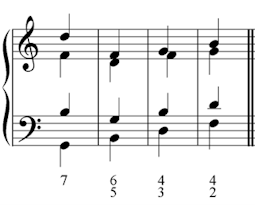There are four figures used for added 7th chords, one for each of the inversions.
Root position 7th chords are written as 7, which is short for 7/5/3.
First inversion chords are 6/5, which is short for 6/5/3.
Second inversion chords are 4/3, which is short for 6/4/3.
Third inversions chords are 4/2, which is short for 6/4/2.
Here are the figured chords for the dominant 7th in C major, which is a chord of G7, containing the notes G, B, D and F:

You can learn these figures in less than a minute. All you need to remember is that you should add a “4” to the last figure to make “4/2”. The other numbers are just the descending numbers from 7: 7 – 65 – 43 – 2
Most of the time the shortened version of the figure is used, but you might see some of the “missed out numbers” reappear if they need accidentals added to them, or if the composer wants to make sure they are not omitted from the chord.
As with all chords, an accidental which appears without a number applies to the third above the bass. Because 7th chords are often added when music is changing key, you can expect lots of accidentals thrown in!
Here’s an example.
Starting in C major, the music quickly modulates through D minor then E minor:

Here’s the same music with the bass figured: The second chord has a “floating” sharp which means the third above the bass (C) must be sharpened. The fourth chord has a 5#, meaning the fifth above the bass (F) must be sharpened, and a “floating” sharp, which means the third, D, is also sharpened.
This is an example of the “missed out” 5 reappearing in the figure, because it’s been altered chromatically. Both of these 7th chords are root position.
